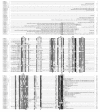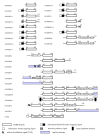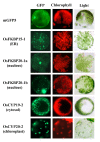Classification of rice (Oryza sativa L. Japonica nipponbare) immunophilins (FKBPs, CYPs) and expression patterns under water stress
- PMID: 21087465
- PMCID: PMC3012604
- DOI: 10.1186/1471-2229-10-253
Classification of rice (Oryza sativa L. Japonica nipponbare) immunophilins (FKBPs, CYPs) and expression patterns under water stress
Abstract
Background: FK506 binding proteins (FKBPs) and cyclophilins (CYPs) are abundant and ubiquitous proteins belonging to the peptidyl-prolyl cis/trans isomerase (PPIase) superfamily, which regulate much of metabolism through a chaperone or an isomerization of proline residues during protein folding. They are collectively referred to as immunophilin (IMM), being present in almost all cellular organs. In particular, a number of IMMs relate to environmental stresses.
Results: FKBP and CYP proteins in rice (Oryza sativa cv. Japonica) were identified and classified, and given the appropriate name for each IMM, considering the ortholog-relation with Arabidopsis and Chlamydomonas or molecular weight of the proteins. 29 FKBP and 27 CYP genes can putatively be identified in rice; among them, a number of genes can be putatively classified as orthologs of Arabidopsis IMMs. However, some genes were novel, did not match with those of Arabidopsis and Chlamydomonas, and several genes were paralogs by genetic duplication. Among 56 IMMs in rice, a significant number are regulated by salt and/or desiccation stress. In addition, their expression levels responding to the water-stress have been analyzed in different tissues, and some subcellular IMMs located by means of tagging with GFP protein.
Conclusion: Like other green photosynthetic organisms such as Arabidopsis (23 FKBPs and 29 CYPs) and Chlamydomonas (23 FKBs and 26 CYNs), rice has the highest number of IMM genes among organisms reported so far, suggesting that the numbers relate closely to photosynthesis. Classification of the putative FKBPs and CYPs in rice provides the information about their evolutional/functional significance when comparisons are drawn with the relatively well studied genera, Arabidopsis and Chlamydomonas. In addition, many of the genes upregulated by water stress offer the possibility of manipulating the stress responses in rice.
Figures










Similar articles
-
Immunophilins and parvulins. Superfamily of peptidyl prolyl isomerases in Arabidopsis.Plant Physiol. 2004 Apr;134(4):1248-67. doi: 10.1104/pp.103.031005. Epub 2004 Mar 26. Plant Physiol. 2004. PMID: 15047905 Free PMC article.
-
Genome wide identification of the immunophilin gene family in Leptosphaeria maculans: a causal agent of Blackleg disease in Oilseed Rape (Brassica napus).OMICS. 2014 Oct;18(10):645-57. doi: 10.1089/omi.2014.0081. OMICS. 2014. PMID: 25259854 Free PMC article.
-
SUMO-conjugating enzyme (Sce) and FK506-binding protein (FKBP) encoding rice (Oryza sativa L.) genes: genome-wide analysis, expression studies and evidence for their involvement in abiotic stress response.Mol Genet Genomics. 2008 Apr;279(4):371-83. doi: 10.1007/s00438-008-0318-5. Epub 2008 Jan 25. Mol Genet Genomics. 2008. PMID: 18219493
-
Plant immunophilins: a review of their structure-function relationship.Biochim Biophys Acta. 2015 Oct;1850(10):2145-58. doi: 10.1016/j.bbagen.2014.12.017. Epub 2014 Dec 19. Biochim Biophys Acta. 2015. PMID: 25529299 Review.
-
Immunophilins: structure-function relationship and possible role in microbial pathogenicity.Mol Microbiol. 1993 Nov;10(3):445-56. doi: 10.1111/j.1365-2958.1993.tb00917.x. Mol Microbiol. 1993. PMID: 7526121 Review.
Cited by
-
The rice thylakoid lumenal cyclophilin OsCYP20-2 confers enhanced environmental stress tolerance in tobacco and Arabidopsis.Plant Cell Rep. 2012 Feb;31(2):417-26. doi: 10.1007/s00299-011-1176-x. Epub 2011 Oct 30. Plant Cell Rep. 2012. PMID: 22041789
-
Expression of a cyclophilin OsCyp2-P isolated from a salt-tolerant landrace of rice in tobacco alleviates stress via ion homeostasis and limiting ROS accumulation.Funct Integr Genomics. 2015 Jul;15(4):395-412. doi: 10.1007/s10142-014-0429-5. Epub 2014 Dec 19. Funct Integr Genomics. 2015. PMID: 25523384
-
Molecular cloning, expression, purification and functional characterization of an antifungal cyclophilin protein from Panax ginseng.Biomed Rep. 2017 Dec;7(6):527-531. doi: 10.3892/br.2017.998. Epub 2017 Oct 10. Biomed Rep. 2017. PMID: 29188056 Free PMC article.
-
Modulation of Abiotic Stress Responses in Rice by E3-Ubiquitin Ligases: A Promising Way to Develop Stress-Tolerant Crops.Front Plant Sci. 2021 Mar 23;12:640193. doi: 10.3389/fpls.2021.640193. eCollection 2021. Front Plant Sci. 2021. PMID: 33833769 Free PMC article. Review.
-
Genome-Wide Identification and Analysis of FKBP Gene Family in Wheat (Triticum asetivum).Int J Mol Sci. 2022 Nov 22;23(23):14501. doi: 10.3390/ijms232314501. Int J Mol Sci. 2022. PMID: 36498828 Free PMC article.
References
Publication types
MeSH terms
Substances
LinkOut - more resources
Full Text Sources
Other Literature Sources

